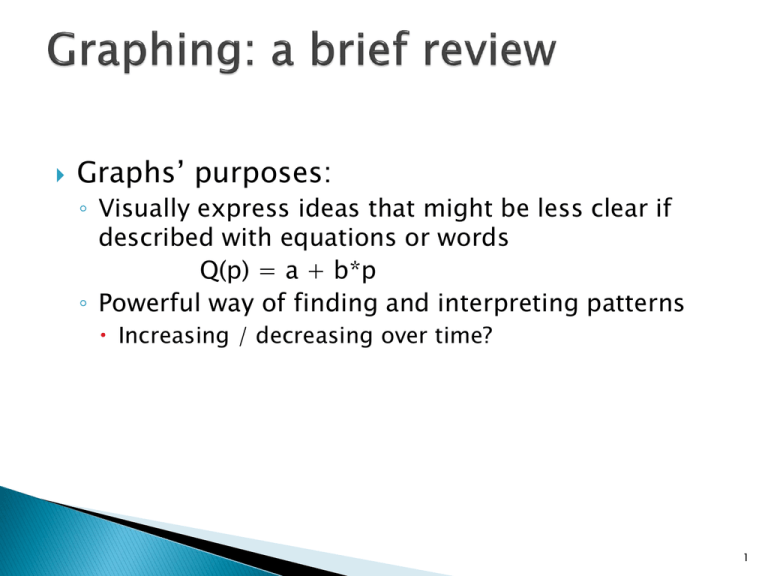
Graphs’ purposes:
◦ Visually express ideas that might be less clear if
described with equations or words
Q(p) = a + b*p
◦ Powerful way of finding and interpreting patterns
Increasing / decreasing over time?
1
Graphs of two variables: the coordinate system
◦ Display two variables on a single graph
◦ Scatterplot
◦ Ordered pairs of points
x-coordinate
Horizontal location
y-coordinate
Vertical location
© 2011 Cengage Learning. All
Rights Reserved. May not be
copied, scanned, or duplicated, in
whole or in part, except for use as
permitted in a license distributed
with a certain product or service or
otherwise on a passwordprotected website for classroom
use.
2
http://www.nytimes.com/interactive/2013/08/21/us/household-incomes-slowclimb.html?ref=politics
CHAPTER 1 APPENDIX
How to Read and Understand
Graphs
A
graph is a two-dimensional representation of a set of numbers, or data.
Time Series Graphs
A
time series graph shows how a single measure or variable
changes over time.
TABLE 1A.1 Total Disposable Personal
Income in the United States, 1975–2012
(in billions of dollars)
Year
1975
1976
1977
1978
1979
1980
1981
1982
1983
1984
1985
1986
1987
1988
1989
1990
1991
1992
1993
Total
Disposable
Personal
Income
1,187.3
1,302.3
1,435.0
1,607.3
1,790.8
2,002.7
2,237.1
2,412.7
2,599.8
2,891.5
3,079.3
3,258.8
3,435.3
3,726.3
3,991.4
4,254.0
4,444.9
4,736.7
4,921.6
Year
1994
1995
1996
1997
1998
1999
2000
2001
2002
2003
2004
2005
2006
2007
2008
2009
2010
2011
2012
Total
Disposable
Personal
Income
5,184.3
5,457.0
5,759.6
6,074.6
6,498.9
6,803.3
7,327.2
7,648.5
8,009.7
8,377.8
8,889.4
9,277.3
9,915.7
10,423.6
11,024.5
10,772.4
11,127.1
11,549.3
11,930.6
FIGURE 1A.1 Total Disposable
Personal Income in the United States:
1975–2012 (in billions of dollars)
Graphing Two Variables
X-axis The horizontal line against which a variable is plotted.
Y-axis The vertical line against which a variable is plotted.
origin The point at which the horizontal and vertical axes intersect.
Y-intercept The point at which a graph intersects the Y-axis.
X-intercept The point at which a graph intersects the X-axis.
Using the Coordinate System
Grade point average is measured on the vertical axis and study time on the
horizontal axis. Albert E., Alfred E., and their classmates are represented by
various points. We can see from the graph that students who study more
tend to get higher grades.
use.
7
Plotting Income and Consumption Data for Households
TABLE 1A.2 Consumption Expenditures
and Income, 2008
Bottom fifth
2nd fifth
3rd fifth
4th fifth
Top fifth
Average
Income
Before Taxes
Average
Consumption
Expenditures
$ 10,263
27,442
47,196
74,090
158,652
$ 22,304
31,751
42,659
58,632
97,003
FIGURE 1A.2 Household Consumption and Income
A graph is a simple two-dimensional geometric representation of data.
This graph displays the data from Table 1A.2.
Along the horizontal scale (X-axis), we measure household income.
Along the vertical scale (Y-axis), we measure household consumption.
Note: At point A, consumption equals $22,304 and income equals $10,263.
At point B, consumption equals $31,751 and income equals $27,442.
Curves in the coordinate system
Negatively related variables
◦ The two variables move in opposite direction
◦ Downward sloping curve
Positively related variables
◦ The two variables move in the same direction
◦ Upward sloping curve
Movement along a curve
Shifts in a curve
© 2011 Cengage Learning. All
Rights Reserved. May not be
copied, scanned, or duplicated, in
whole or in part, except for use as
permitted in a license distributed
with a certain product or service or
otherwise on a passwordprotected website for classroom
use.
9
Slope
slope A measurement that indicates whether the relationship
between variables is positive or negative and how much of a response
there is in Y (the variable on the vertical axis) when X (the variable on
the horizontal axis) changes.
Y2 Y1
Y
X X 2 X 1
FIGURE 1A.3 A Curve with (a) Positive Slope and (b) Negative Slope
A positive slope indicates
that increases in X are
associated with increases in
Y and that decreases in X
are associated with
decreases in Y.
A negative slope
indicates the
opposite—when X
increases, Y decreases;
and when X decreases,
Y increases.
FIGURE 1A.4 Changing Slopes Along Curves
Demand Curve
Price of
Novels
$11
10
9
8
7
6
5
4
3
2
1
(5, $10)
(9, $9)
(13, $8)
(17, $7)
(21, $6)
(25, $5)
Demand, D1
30 Quantity of novels
purchased
The line D1 shows how Emma’s purchases of novels depend on the price of
novels when her income is held constant. Because the price and the quantity
demanded are negatively related, the demand curve slopes downward.
0
5
10
15
20
25
.
13
Shifting Demand Curves
Price of $11
Novels
10
9
8
7
6
5
4
3
2
1
0
When income
increases, the
(13, $8)
demand curve shifts
to the right.
(16, $8)
(10, $8)
D2 (income=
$40,000)
When income
decreases, the
demand curve
shifts to the
left.
5
D3
(income= D1
$20,000) (income=
$30,000)
10 1315 16 20
25
30 Quantity of novels purchased
The location of Emma’s demand curve for novels depends on how much income she
earns. The more she earns, the more novels she will purchase at any given price, and
the farther to the right her demand curve will lie. Curve D1 represents Emma’s original
demand curve when her income is $30,000 per year. If her income rises to $40,000
per year, her demand curve shifts to D2. If her income falls to $20,000 per year, her
demand curve shifts to D3.
14
Slope
◦ Ratio of the vertical distance covered
◦ To the horizontal distance covered
◦ As we move along the line
Δ (delta) = change in a variable
The “rise” (change in y) divided by the “run” (change in
x).
y
Slope
x
.
15
Slope
◦ Fairly flat upward-sloping line
Slope = small positive number
◦ Steep upward-sloping line
Slope = large positive number
◦ Downward sloping line
Slope = negative number
◦ Horizontal line
Slope = zero
◦ Vertical line
Infinite slope
.
16
Calculating the Slope of a Line
Price of
Novels
$11
10
9
8
7
6
5
4
3
2
1
0
(13, $8)
6-8=-2
(21, $6)
21-13=8
5
10 13 15
Demand, D1
20 21 25
30 Quantity of novels purchased
To calculate the slope of the demand curve, we can look at the changes in the x- and
y-coordinates as we move from the point (21 novels, $6) to the point (13 novels, $8).
The slope of the line is the ratio of the change in the y-coordinate (–2) to the change in
the x-coordinate (+8), which equals –1⁄4.
17


